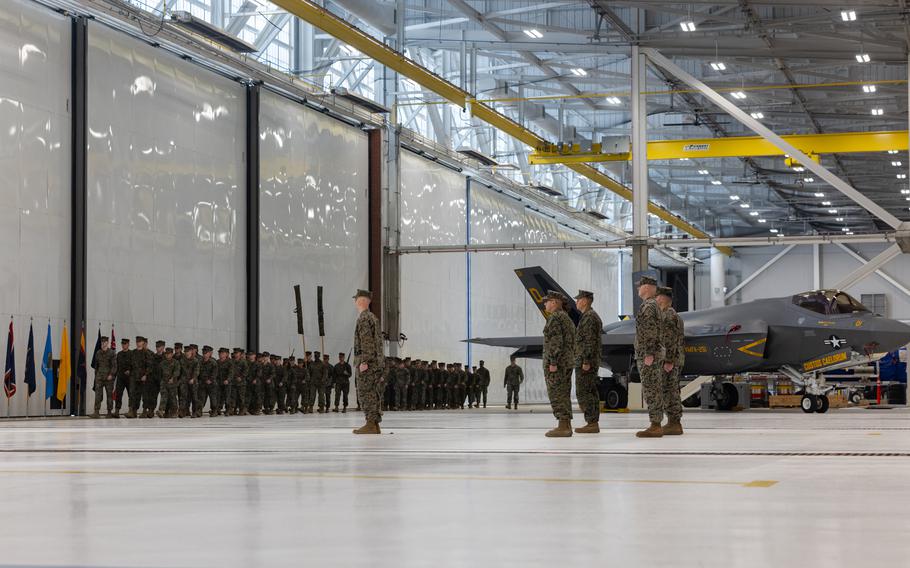
The Marine Corps has activated its first F-35C Lightning II stealth fighter squadron on the East Coast with the legendary Marine Fighter Attack Squadron 251. (Lance Cpl. Orlanys Diaz Figueroa/U.S. Marine Corps photo)
The Marine Corps activated its first F-35C Lightning II stealth fighter squadron on the East Coast on Thursday, with the reactivation of the legendary Marine Fighter Attack Squadron 251 at Marine Corps Air Station Cherry Point near Camp Lejeune, N.C.
The return of VMFA 251 marked a significant moment in the Corps’ efforts to modernize its fleet to fight a modern, large-scale war against an enemy with similar capabilities to the United States, officials said.
The squadron was inactivated in April 2020 at its prior base Marine Corps Air Station Beaufort, S.C., after flying the F/A-18 Hornet fighter jet since 1986, including numerous operations in Afghanistan and Iraq.
The unit, nicknamed the Thunderbolts or T-Bolts, traces its lineage to World War II in which its pilots flew the F4F Wildcat, an aircraft carrier-based fighter. They flew the Wildcat in Pacific campaigns including the battles of Guadalcanal, the southern Solomons, Santa Cruz, Luzon and the southern Philippines, according to a Defense Department history of the squadron. The unit earned two Presidential Unit Citations “for extraordinary heroism” for its efforts during World War II. VMFA 251 also fought in the Korean War and flew NATO no-fly zone enforcement sorties over Bosnia and Herzegovina in the 1990s.
“The T-Bolts are humbled and honored for the privilege of carrying that proud legacy forward,” Lt. Col. Evan Shockley, the squadron’s commander, said in a statement. “Our immediate focus is working toward initial operational capability, which means that VMFA 251 has enough operational F-35C Lightning II aircraft, trained pilots, maintainers and support equipment to self-sustain its mission essential tasks. Following that, we will turn our attention toward reaching full operational capability to ensure that, when called upon, the T-Bolts will stand ready to serve our great nation.”
The squadron is expected to reach initial operating capability next year, said 1st Lt. Jacob Ballard, 2nd Marine Air Wing spokesman.
It’s expected be fully operational no later than 2026, which would allow the squadron to deploy globally, Ballard said.
All Marine F-35 squadrons are planned to have 10 primary aircraft, according to a 2022 service aviation plan.
The unit’s 2020 inactivation came shortly after it returned to MCAS Beaufort from the Middle East, where it was flying anti-Islamic State group operations in Iraq and Syria. Marine officials at the time said the inactivation would be temporary as the Corps transitioned the unit to fly the F-35 from Cherry Point.
VMFA 251 received its first F-35C in September as it prepared to reactivate with the Corps’ most advanced aircraft, service officials said.
The F-35C is the longest-range stealth fighter of the three variants of the aircraft, which is the most expensive weapons system in history. The C model, flown by the Navy and Marine Corps, is designed to fly from aircraft carriers and boasts a range of some 1,200 nautical miles, according to the Pentagon.
Marines last month used the F-35C for the first time in combat, flying the fighters from the USS Abraham Lincoln to strike Houthi targets in Yemen, military officials said.
Some Marine squadrons fly the F-35B, which is designed to takeoff on short runways, including from amphibious assault ships, and land vertically, like a helicopter.
VMFA 251 is part of the 2nd Marine Aircraft Wing, the Corps’ primary East Coast air unit, which is part of the 2nd Marine Expeditionary Force.
Stars and Stripes reporter Lydia Gordon contributed to this report.